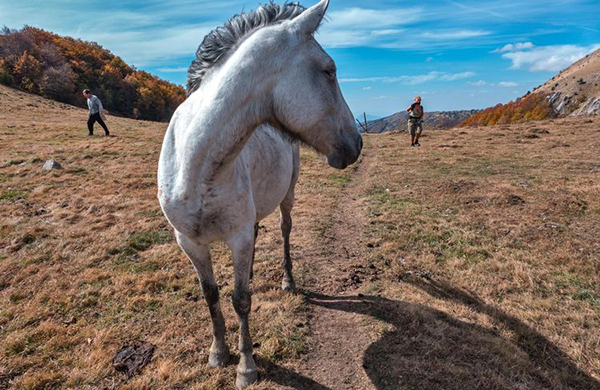How to Catch a Loose Horse
By: Susy White and Taylor Fabus, Michigan State University Extension
Although undesirable, horses can get loose in many situations, such as at horse shows and events, while traveling if you stop for layovers, in the show ring, and even from home pastures or stables. This article will focus on horses who have gotten loose on their home property. Some horses maintain a calm, cool and collected composure, and are easily caught with a slow, gentle approach. Other horses, even the most trained and ordinarily even-tempered, can become dangerously flighty. So, when someone yells, “The horses are loose!” what should you do?
- Keep calm and check your surroundings. If you are on a horse, you may want to dismount depending if you will have more control on or off the horse. If you are standing, move toward a fence line, tree or large object. Never stand or jump in front of a galloping horse—they are highly likely to run you over, especially when frightened. If you are able, direct all people to safety, telling them where to stand or how to help.
- Check gates and perimeters: Close or block any gates that might secure a perimeter around the loose horse. Be aware that frightened loose horses might jump things they might not ordinarily jump.
- Determine which horse or horses are loose and which are contained. Contain or gain control of any horses that are not currently loose. The loose horse is more likely to return to other horses. The more horses that are loose or out of control, the larger the problem can become.
- Grab a bucket of grain and something to secure the horse. A halter and lead rope would be your first choice, but a rein, dog leash, belt or even binder twine can work temporarily.
- Station one person at home or in a central location to report if the horses have returned home, catch the horses if they return and keep the status of “where the horses are.”
- If the horses have left your sightline or have moved off your property, start calling neighbors and law enforcement. Especially if there are any roads nearby, loose horses can become very dangerous and this merits a call to 911. Be prepared with a clear but simple description, for instance, “Two horses are loose, a white Quarter Horse mare and bay/brown Arabian gelding.” Also, give them the address of the property from which the horses left.
- The search for lost horses may include motorized vehicles, bicycles, people on foot, etc. The goal is to try to keep the horses in your sightline and approach the horses from the side opposite their home so that if they do flee, they move closer toward their home, not further away. Stay very alert of possible danger to the horses but also to other people and animals.
- The search for lost horses may also require tracking if they have disappeared completely. Look for hoof prints in the grass or snow. Horses tend to go uphill as opposed to downhill and into open spaces as opposed to thickly covered areas.
- Once horses are caught, they can be picked up in a horse trailer or hand walked home. Although you may be frustrated, do not discipline your horse for getting loose or running; reward them for being caught and head back to the stable.
- Once home, check the horse over for injuries, watch for signs of colic or distress and keep your veterinarian on call in case problems arise.
What not to do
- Wait until they come home on their own and nothing else.
- Try to catch them by yourself without help.
- Attempt to run another horse down while on horseback.
How to avoid loose horses
- Maintain fences, gates, stables and property.
- If your horses get out once, identify the problem so you can try to avoid it happening again.
- Practice catching your horse with a cue such as a call, hand signal, etc., in a larger yet confined area to increase the likelihood your horse will return when cued.
- Post signs reminding people to close gates, secure restricted areas, etc.
Additional helpful resources
Handling a Mount when a Horse is Loose
This article was published by Michigan State University Extension. For more information, visit https://extension.msu.edu. To have a digest of information delivered straight to your email inbox, visit https://extension.msu.edu/newsletters. To contact an expert in your area, visit https://extension.msu.edu/experts, or call 888-MSUE4MI (888-678-3464).











